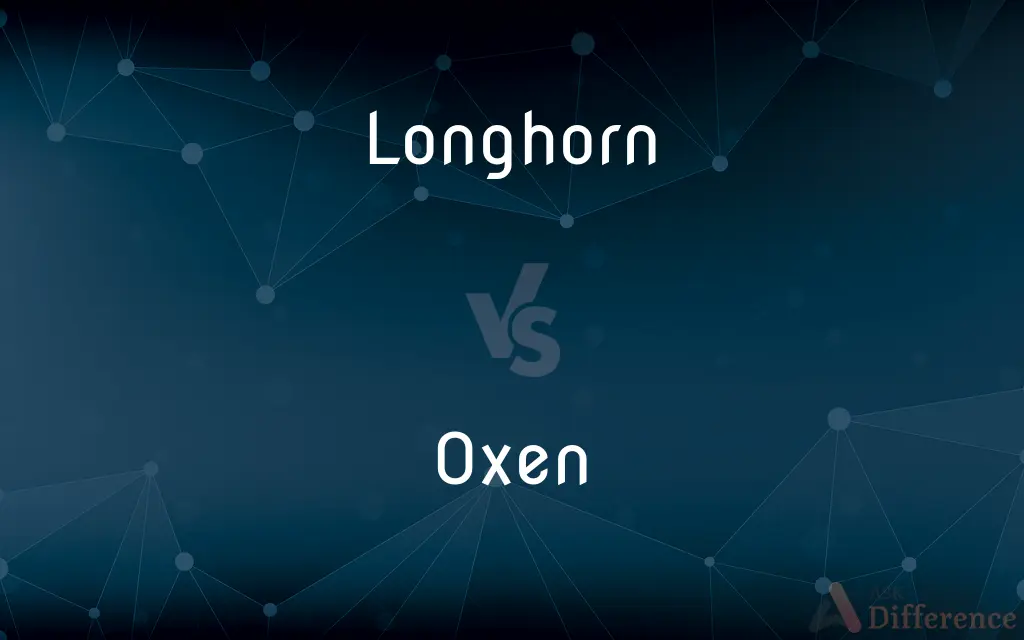Longhorn vs. Oxen — What's the Difference?
Edited by Tayyaba Rehman — By Fiza Rafique — Updated on October 12, 2023
Longhorn refers to a breed of cattle with long horns, while Oxen are adult male cattle trained to work, usually castrated.

Difference Between Longhorn and Oxen
Table of Contents
ADVERTISEMENT
Key Differences
Longhorn is a term specifically denoting a breed of cattle known for its characteristically long horns. Originating from Spain and brought to America by Spanish settlers, Longhorns are not just notable for their horns, but also for their resilience and ability to adapt to harsh conditions. On the other hand, Oxen refers to any breed of adult male cattle that have been castrated and trained for draft work, such as plowing or hauling.
Longhorns have played an important role in the history of American cattle ranching. They became particularly associated with Texas, as these cattle roamed wild across the state following the economic collapse after the Civil War. Oxen, on the other hand, have been pivotal in agriculture worldwide, as their strength has been harnessed for various forms of labor for thousands of years.
A Longhorn can be either male or female, and its most distinct feature is its long, arching horns, which can extend to over seven feet from tip to tip for some individuals. In contrast, Oxen don't have a specific physical characteristic that defines them. Instead, they are distinguished by their role as working animals, and their castration which makes them docile.
When discussing beef or dairy production, the Longhorn breed may come up because of its lean meat and historical significance. Oxen rarely play a role in discussions of meat or dairy production as they are primarily valued for their labor.
Longhorns, with their unique appearance, often appear in cultural symbols, especially in the American Southwest. They represent a rugged, untamed heritage. Oxen, with their long history of servitude to humans, often symbolize strength, endurance, and labor in various cultures around the world.
ADVERTISEMENT
Comparison Chart
Definition
Breed of cattle with long horns.
Adult, castrated male cattle trained for work.
Origins
Spain, became popular in the U.S.
Worldwide, ancient history of use.
Gender Specificity
Can be male or female.
Always male.
Primary Use
Beef production, historical significance.
Labor, like plowing or hauling.
Symbolism
Ruggedness, American Southwest heritage.
Strength, endurance, hard work.
Compare with Definitions
Longhorn
A breed of cattle with characteristic long horns.
The rancher imported several Longhorn cattle to diversify his herd.
Oxen
Adult, castrated male cattle trained for draft work.
The farmer used his oxen to plow the fields.
Longhorn
Cattle with horns that can measure over seven feet from tip to tip.
Tourists were amazed by the impressive span of the Longhorn's horns.
Oxen
Symbol of strength and endurance in many cultures.
In many stories, oxen represent unwavering strength and patience.
Longhorn
Cattle known for resilience in tough conditions.
The Longhorn adapted well to the arid Texas landscape.
Oxen
Strong animals primarily used for labor.
Oxen have been indispensable in agricultural tasks for centuries.
Longhorn
Cattle associated with Texas and the American Southwest.
Texas Longhorn is a symbol of the state's ranching heritage.
Oxen
Cattle known for docility after castration.
Unlike bulls, oxen are more docile and easier to manage.
Longhorn
Beef cattle producing lean meat.
Many prefer Longhorn beef for its reduced fat content.
Oxen
Animals trained to work in pairs.
The pair of oxen pulled the heavy cart with ease.
Longhorn
Any of a breed of cattle with long horns and a brown and white coat, developed in England for meat and milk and now rare.
Oxen
Plural of ox.
Longhorn
A Texas Longhorn.
Oxen
Plural of ox
Longhorn
Any of various cow's milk cheeses, usually Colby or Cheddar, that are molded into a long cylinder and often cut into moon or half-moon shapes for sale.
Oxen
Of, relating to, or resembling an ox; oxlike
Longhorn
A breed of beef cattle, having long horns, bred in Texas and other parts of southwest United States.
Oxen
Domesticated bovine animals as a group regardless of sex or age;
So many head of cattle
Wait till the cows come home
Seven thin and ill-favored kine
A team of oxen
Longhorn
A long-horned animal, as a cow, goat, or beetle. See Long-horned.
Longhorn
The Texas longhorn.
Longhorn
Long-horned beef cattle formerly common in southwestern United States
Common Curiosities
Are all cattle with long horns called Longhorns?
No, Longhorn specifically refers to a breed, not just any cattle with long horns.
Are Longhorns native to the U.S.?
No, they originated from Spain but became iconic in the U.S.
Is Longhorn beef different from other beef?
Yes, Longhorn beef is often leaner than beef from other breeds.
Are Longhorns more resilient to diseases?
Historically, Longhorns were known for their resilience to certain conditions and diseases.
How old are oxen when they start working?
Oxen training can start when they're young, but they work as adults.
Can oxen be of any cattle breed?
Yes, oxen can come from any breed; they're defined by their role and castration.
Do Longhorns come in different colors?
Yes, Longhorns can have various coat colors and patterns.
Why are oxen castrated?
Castration makes oxen more docile and manageable for work.
What tasks are oxen commonly used for?
Plowing, hauling, and other forms of labor requiring strength.
Why are oxen symbols of strength?
Due to their historic role in heavy labor and their endurance.
Are oxen always worked in pairs?
Often, but not always. Their training and use can vary.
Is there a difference in horn size among Longhorns?
Yes, horn size varies, but they are characteristically long.
Can oxen be used for meat after their work-life?
Yes, though they're primarily valued for labor, oxen can be used for meat.
Is the Texas Longhorn the same as any Longhorn?
Texas Longhorn is a specific breed under the larger Longhorn category.
Are Longhorns aggressive?
Like all cattle, individual temperament can vary, but they're generally not aggressive.
Share Your Discovery

Previous Comparison
Adenine vs. Guanine
Next Comparison
Amortization vs. ImpairmentAuthor Spotlight
Written by
Fiza RafiqueFiza Rafique is a skilled content writer at AskDifference.com, where she meticulously refines and enhances written pieces. Drawing from her vast editorial expertise, Fiza ensures clarity, accuracy, and precision in every article. Passionate about language, she continually seeks to elevate the quality of content for readers worldwide.
Edited by
Tayyaba RehmanTayyaba Rehman is a distinguished writer, currently serving as a primary contributor to askdifference.com. As a researcher in semantics and etymology, Tayyaba's passion for the complexity of languages and their distinctions has found a perfect home on the platform. Tayyaba delves into the intricacies of language, distinguishing between commonly confused words and phrases, thereby providing clarity for readers worldwide.
















































